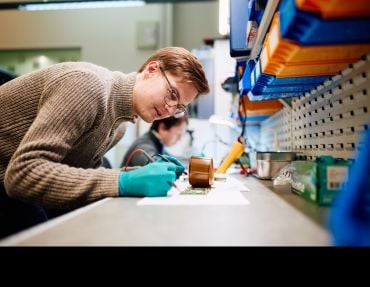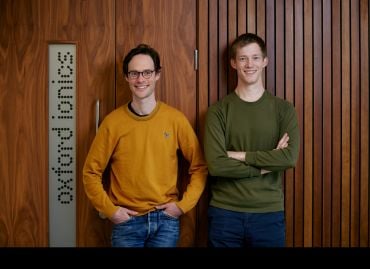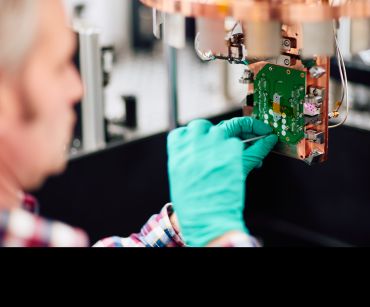
Dr Chris Ballance, quantum computing’s up-and-coming star
Quantum computers are revered for their potential to revolutionise the world, harnessing an untapped power that seems the stuff of science fiction to most. From the initial blue-sky ideas through to leading high-performance quantum systems that are solving real problems, Dr Chris Ballance, Future Leaders Fellow at Oxford University Physics, has been at the forefront of the field from conception to reality. By Matthew Rogers.
 A scientist tests an upgrade package for a quantum computer.
A scientist tests an upgrade package for a quantum computer.Pursuing physics in his undergraduate studies, the field of quantum computing scratched an itch for Ballance, because it was something truly novel that had the promise to actually make a difference. ‘Something that in a few years can go from a glimmer of hope all the way through to defining the state of the art, something that nobody else has done before: I found that incredibly exciting.’
After obtaining his PhD in Oxford in 2014, Ballance has been at the forefront of developing new techniques and technologies to manipulate qubits at sufficient scale to build useful quantum computers. He hasn’t stopped pushing the boundaries of quantum computing during his research, setting new world records, including the highest performance quantum logic gates, the longest qubit memory coherence time, and the fastest and highest performance quantum network.
Intriguingly, it was always clear to Dr Ballance that at some point his work would evolve into a spin-out company. ‘Even though I couldn’t have vocalised that at that point, I knew that success for me wouldn’t be just sitting in a lab thinking “this could be incredibly exciting.” I knew I would want to follow the work all the way through to making an impact on people’s lives.’
In 2019, Dr Ballance co-founded his company Oxford Ionics with his colleague of many years, Dr Tom Harty. Together, they had been working at the forefront of quantum computing for almost a decade at Oxford University Physics, where they both earned their PhDs, and where Dr Ballance retains a lead research role – pushing new boundaries in one of the most exciting areas of physics and innovation.
‘Building computers atom by atom’
The magic of the techniques we’ve developed allows us to marry the ability to build out large scale chips, whilst being able to trap and control the individual atoms in a perfectly quantum way.
Dr Chris Ballance
Before you even get down to the technical details, there is one fundamental challenge with quantum computing. As Dr Ballance explains quite simply, ‘Nature doesn’t like to be quantum.’
Most have heard of Schrodinger’s Cat, who lives in a box and is famously both dead and alive until we open the box and check. However, these seemingly absurd quantum phenomena are never seen in real life. Cats are very firmly either dead or alive, not both.
Dr Ballance says, ‘When you’re building a quantum computer, you’re really trying to build Schrodinger’s Cat atom by atom, and maintain it in a quantum state.’
The unique power of quantum computing is that its fundamental building blocks, the qubits, can harness these quantum superpositions and be in multiple states at once. Classical computer bits, on the other hand, are distinctly either a zero or a one.
 Dr Tom Harty and Dr Chris Ballance, founders of Oxford Ionics.
Dr Tom Harty and Dr Chris Ballance, founders of Oxford Ionics.Dr Ballance explains, ‘The magic of the techniques we’ve developed allows us to marry the ability to build out large scale chips, whilst being able to trap and control the individual atoms in a perfectly quantum way.’
The quantum states are so well controlled that they have a coherence time of minutes before they collapse, compared to other technologies that only achieve micro or milliseconds. This is essential if these states are to last long enough to be useful to us – for instance, in solving problems. As Dr Ballance says: ‘With this approach, you can put the system in a quantum superposition state, go and have a cup of tea and come back, and after 10 minutes or more they are still there.’
A researcher turned entrepreneur
It is tremendously exciting to build the workplace of one’s dreams. We have created a culture that is based around allowing people to be very flexible and achieve their best work.
Dr Chris Ballance
When it comes to the business side of running a tech company, Dr Ballance admits, ‘It is a massive learning experience to go from making something out of chewing gum and toothpicks that looks the part and inspires you, to making reliable robust building blocks you actually build a company out of.’
Fortunately, Oxford Ionics’ mission of building the world’s best quantum computers is an incredibly powerful attractor, such that they now have ‘a collection of some of the best people around the world on this.’
The team of around 50 individuals is set to grow exponentially to more than 80 by the end of the year. That includes scientific experts on the foundational theory, people who have built the world’s best chips, and the software engineers; not to mention those with expertise in business, finance, and marketing.
‘Our view at Oxford Ionics is always that the best perk you can possibly have working in this space is the amazing inspirational people around you’, Dr Ballance maintains. ‘If you have that, then you don’t need anything else.’
 A technician installs a quantum processor into Oxford Ionics' world leading quantum computer.
A technician installs a quantum processor into Oxford Ionics' world leading quantum computer.2019 was a significant year for Dr Ballance: as well as founding Oxford Ionics, he was also appointed as the Future Leaders Fellow in the Department of Physics. When asked how he juggles these two roles, Dr Ballance argues that they are two sides of the same coin. ‘You can’t do one without the other. It is a privilege to be in a position where I can do both.’
I did ask Dr Ballance what he likes to get up to outside the lab, but it was bold of me to assume he has any free time. ‘I have three children, so at the moment my time is spent chasing them around swimming pools and parks and up trees’, he chuckles.
In a beautiful circle of life moment, Dr Ballance is now in his own father’s shoes. ‘My father used to have to check under my bed for cogs and other pieces of toys, and then try and work out where they had come from. I find myself having to do the same with my children, and only allow them access to screwdrivers under supervision.’ Chip off the old block.
What does the quantum future look like?
The world of quantum computing is very new and exciting, and entirely foreign to most of us. The big thing we all are curious to find out is what can quantum computers actually do, and how will they affect our lives? Dr Ballance remains humbly but delightedly ignorant.
‘As with all forms of new technology and computing, what we have seen time and time again is that the killer application is not one you’ve anticipated’ he admits.
Probably the most valuable applications of quantum computing are the ones that we haven’t come across yet. So, the thing I am most looking forward to is giving people access to these new forms of computer and seeing what they can do with them.
Dr Chris Ballance
For example, the first classical computers were built to solve problems that could in principle be solved by hand, but would simply take too long and were liable to human error. This is a far cry from where computing is now, with internet banking, animated films, and social media: applications no one could have ever predicted back in the 20th century.
The same is true for quantum computing. We already have a list of things we think quantum computers will allow us to do, from materials discovery and drug development to better aerodynamic modelling or financial portfolio optimisation. But this might be just the tip of the iceberg.
Dr Ballance theorises, ‘Probably the most valuable applications are the ones that we haven’t come across yet, but will come with the second and third revolutions. So, the thing I am most looking forward to is giving people access to these new forms of computer and seeing what they can do with them.’
Beyond Oxford Ionics, Dr Ballance thinks that the UK is in a well thought-through position. Our country was one of the first to set up a national quantum strategy way back in 2014, which has since set an example for the EU and the US.
‘Now the UK has started properly investing, there is a wonderful crop of fledgeling quantum companies like ours’ he explains, animatedly. ‘The question is whether the technology in 5–10 years’ time stays in the UK or if, like many other technologies, it ends up getting disseminated across lots of other countries. The UK’s investment in quantum is great: and it needs to be done with sufficient conviction to make sure it continues.’
Quantum computing is already starting to take off internationally as well. Dr Ballance and his colleagues regularly attend international summits which are increasingly attracting more than just researchers. Big Pharma companies and world-leading banks are often present too, keen to come and ascertain the benefits that quantum computing could bring to them.
‘One of the great things about being a scientist is going around and telling everyone all the amazing work you are doing’ he grins. ‘It is really wonderful to watch the field grow and have more and more people brought in.’
When it comes to quantum computing, the difficulties of working out how the different pieces integrate together are good old-fashioned engineering challenges that can be solved with good old-fashioned engineering techniques.
Dr Chris Ballance
In 1991, when Dr Ballance was just a child, the first ideas of quantum algorithms were just beginning to be explored at Oxford. Then in 2010, when he began his PhD, the science was ready for Dr Ballance and his team to generate the highest performing qubits and the best entanglement of any physical system, achieving error rates low enough to solve practical problems. And now, the systems have been so well iterated, developed, and refined, that he can build up chips with routinely high performance.
‘It has all snowballed from a few small research grants for a few small bits of weird theory, 40 years before the impact was really felt’, he says.
This idea of blue-sky research is a story that we see playing out time and time again across research. ‘Stuff that seems completely “out there” 20 years ago eventually translates into cool experimental science, which in another 20 years transforms into fully-fledged companies and industries.’
He highlights the vital importance of early-stage funding to get these ideas off the ground and generate these industries. There’s no way of skipping that long-term investment if we want pioneers of new technology to get their ideas into the world.
It is immensely gratifying for Dr Ballance to see the work that he has believed in for the last 15 years reach an inflection point and begin to make a tangible difference. He believes the phrase “it’s an overnight success that took 10 years” is definitely applicable.
‘A tremendous amount of blue-sky research over the past two decades is now taking off, and over the next few years quantum computing will go from being a mere scientific curiosity to an everyday piece of the computing landscape.’
You can find out more about Oxford Ionics on their website.
You can discover more on the pioneering research by Dr Ballance and others at Oxford University Physics Department on their website here.